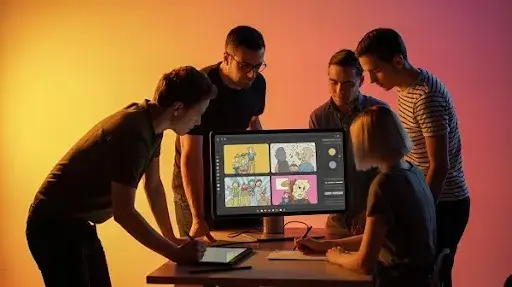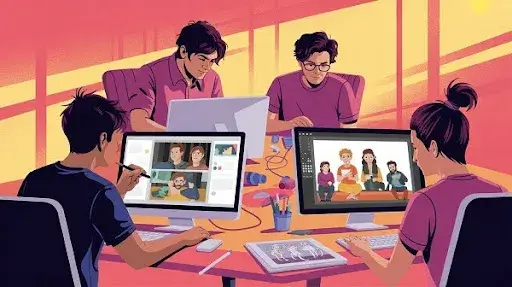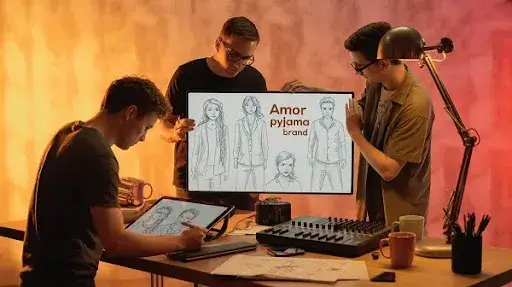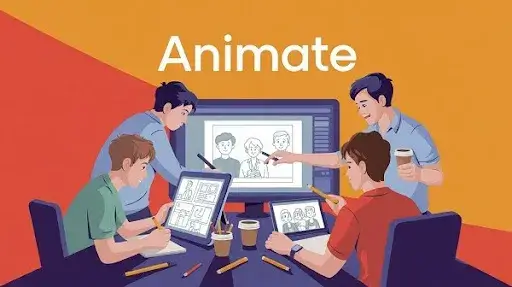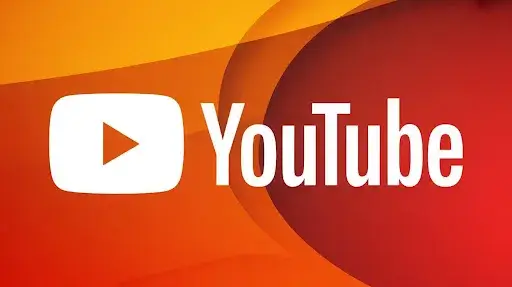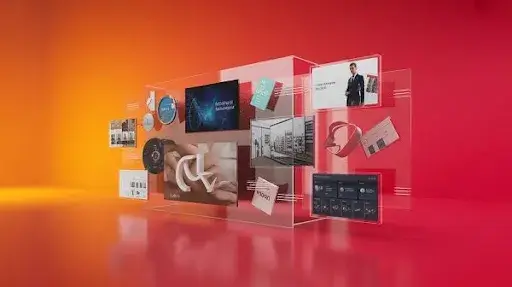Are you just getting started with animation or aiming to fine-tune your process for flawless video production?
We’ve broken down the entire journey into nine simple steps. These steps are based on nearly two decades of experience in TV, commercial video, and explainer video production.
By the time you finish reading, you’ll have a clear roadmap—one that makes your video production process flow as seamlessly as a well-oiled machine.
1. Brief & Research
Every successful video begins with clarity. Start by gathering all the essential details:
- What is the main purpose of the video?
- What problem does the product or service solve?
- Who is the target audience?
- What makes this solution different from competitors?
Create a structured brief that covers these points and use it as your foundation. Remember, many clients may overlook key details or provide too much irrelevant information. It’s your job to identify what’s important and filter out distractions.
Once the brief is ready, involve your team to analyze the market, competitors, and target audience thoroughly. A strong research phase ensures your final video isn’t just high-quality—it’s strategically positioned to stand out in a crowded space.
2. Crafting the Concept & Setting the Strategy
The concept is the backbone of your explainer video. Think of it as the architectural plan before you start writing the script.
Based on the brief and research, decide what storytelling approach will best achieve the project’s goals. For example:
- Should the video follow a Problem–Solution format with a narrative?
- Or should it focus on a straightforward demonstration of how the product works?
Also, consider where the video will be published. A video made for a website might look different from one designed for social media. In many cases, you’ll need multiple versions—vertical, square, and horizontal—with tailored calls-to-action for each platform.
Once the concept is solid, pass it on to your content team. Their task is to transform this strategic framework into a script that’s not just informative but also engaging and easy to follow.
3. Script
If there’s one piece of advice I could give, it’s this: follow the KISS principle – Keep It Simple, Stupid.
Don’t try to impress with complicated words or academic-style writing. Your script should be smooth, clear, and focused on the core message. Packing in too much information often makes people forget the main point.
Remember, your video has both a script and visuals. Highlight the key benefit clearly, and let your artists bring the details to life. Think of the script and visuals as puzzle pieces—they need to fit together perfectly to tell your story.
Additional Points to Consider:
- Script as Strategy: Your script isn’t just the words—it sets the tone and direction of your video.
- Know Your Audience: Speak directly to your ideal customer and address their needs.
- Choose Your Tone: Decide whether you want to educate, surprise, entertain, or provoke thought.
- Hook Early: Capture attention within the first 5-8 seconds. Avoid long intros.
- Focus on Benefits: Emphasize what your product or service can do for your audience, not just its features.
- Clear Call to Action (CTA): End with a specific, actionable instruction. Tell viewers exactly what to do next.
- Customize CTA: If your video is used in different marketing funnels, consider creating tailored CTAs for each.
4. Storyboard
Next, it’s time to bring your ideas to life with a storyboard. This is a visual roadmap of every scene and action in your video. A good storyboard helps you:
- Avoid Surprises: Plan visuals ahead to prevent unexpected production issues and extra costs.
- Ensure Proper Pacing: Maintain balance and rhythm throughout each scene.
- Visualize Flow and Timing: See how your story unfolds and how each scene transitions.
To refine your vision, consider using a mood board. This tool helps define your video’s overall style and feel and can include references for:
- Character Design: Especially important if your video has characters.
- Background Design: Set the scene and environment.
- Color Palette: Establish visual tone and consistency.
- Animation Style: Decide how movement and action will feel.
- Overall Tone and Feel: Ensure all elements create a cohesive, immersive experience.
Once your storyboard is complete, review the timing carefully and make any necessary tweaks to the script before recording your voiceover. This prevents costly changes during production and ensures everything comes together seamlessly.
5. Illustrations
After finalizing the storyboard for all scenes, it’s time to bring the story to life with colors. We follow a proven approach to make this process smooth and effective.
Identify Key Visuals
We start by selecting 2-4 storyboard frames that capture the most important elements—key characters, products, or major scenes. Focusing on these visuals first ensures we highlight what truly matters.
Develop the Visual Style
Next, we create high-quality illustrations for these key frames. Every detail is carefully considered, from colors to textures, ensuring the visuals reflect the final desired look. We consistently apply brand colors and accents so the design aligns perfectly with the brand’s identity. This step also helps minimize revisions during the full illustration phase.
Approval
Once the visual style is approved, we proceed to illustrate the remaining scenes.
By following this method, we ensure everyone is aligned with the overall visual direction before investing time in the full project. This approach keeps the process efficient while delivering visual storytelling that engages and resonates from start to finish.
6. Voice Over
Voiceover is a vital element of animation that often doesn’t get the attention it deserves. The right tone and delivery can dramatically influence how your audience receives your message. Here’s a clear, step-by-step approach to finding the perfect voice for your project:
Start with an Audition: Begin by organizing a voice audition on platforms like voice.com. Define your preferences for tone, gender, accent, and style to ensure candidates align with your project’s vision.
Review Samples: Ask voice artists to record a short portion of your script. This gives you a realistic sense of how their voice will work with your animation.
Client Selection: Narrow down the best options and present them to your client for final approval.
Record the Narration: Once approved, collaborate with the chosen voice talent to record the full narration professionally.
Tips for Best Results:
Go Beyond Demos: Don’t rely only on pre-recorded demos. Customized auditions tailored to your script and audience will provide a clearer picture of the right voice for your project.
Match the Message & Audience: The voice should complement your animation style and resonate with your audience. Consider the emotions you want to convey and select a voice that supports that goal.
Investing time in casting the right voiceover talent can elevate your animation and help your message truly connect with viewers. Remember, the right voice can make a world of difference!
7. Animation
This is where your vision truly comes to life!
With a finalized script, storyboard, and visual style, the animation stage becomes a smooth and productive process. To ensure efficiency:
Finalize Creative Elements: Make sure all components, especially character designs and key visuals, are approved before starting animation. Making changes during this stage can be costly and slow down production.
Follow Your Plan: By adhering to your storyboard and style guidelines, you’ll maintain consistency and avoid unnecessary revisions.
By preparing thoroughly and following these steps, the animation process will run efficiently, resulting in a polished and engaging final product. Proper planning and attention to detail during pre-production will make the animation stage feel seamless and enjoyable.
8. Sound Design
Music plays a vital role in shaping the tone of your animation and influencing how viewers perceive its pacing. Choosing the right track is essential, but equally important is the mixing process. Music should enhance the atmosphere without overpowering the visuals or dialogue.
If you plan to use music from royalty-free platforms, make sure the license you obtain aligns with how and where your video will be distributed. For a more unique touch, consider hiring a composer to create a custom soundtrack specifically tailored to your animation.
After selecting music, adding sound effects can significantly enrich the viewer’s experience. Thoughtful sound effects emphasize key actions, highlight important moments, and make your animation feel more immersive and dynamic.
9. Finalizing Your Video: The Last Stage
This final stage is all about polishing your animation to perfection. It involves refining minor details, adding finishing touches, and exporting your video in the correct format for your intended platform.
To further enhance accessibility and engagement, consider these additional steps:
- Adding Subtitles: This ensures your content is accessible to a wider audience and benefits viewers who watch without sound.
- Alternative Endings: Experiment with different endings, particularly for calls to action, to determine which resonates best with your audience.
- Social Media Edits: Create shorter versions of your video tailored for social media platforms, helping you maximize reach and engagement.
FAQ
How long does animation production take?
Creating a 1-2 minute animation generally takes 5-8 weeks. The exact timeline depends on the complexity and style of the animation. Keep in mind that this estimate usually excludes the time needed for client reviews and revisions.
What is pre-production in an explainer video process?
Pre-production encompasses everything that happens before actual video creation begins. This stage includes research, brainstorming concepts, and writing the script. Production officially starts once the visuals and animations begin to take shape.
What is post-production?
Post-production is the final phase of animation production. It involves refining the animation, editing, and adding soundtracks or sound effects. Once everything is polished, the video is rendered in the appropriate format and resolution for your chosen platforms.
What is a “pipeline” in animation video production?
The animation production pipeline is essentially the roadmap for creating an animated video. It’s a structured workflow that ensures every step happens in the right order. A typical animation production pipeline includes:
- Research
- Concept development
- Scriptwriting
- Style frames
- Storyboarding
- Voice-over recording
- Animation
- Soundtrack and sound effects
- Revisions
- Finalization
What are the main factors that influence production price?
The cost of producing an animated video depends on several key factors:
- Quality and complexity of the animation
- Visual style (3D animation usually requires more time and is therefore more expensive than 2D)
- Illustrations and design work
- Music (custom-composed or stock tracks)
- Sound effects
- Voice-over talent
- Video length
- Production timeline (how quickly you need the final video)
How do I choose the best animation style for my brand?
The right animation style depends on your marketing goals and brand identity. We provide references, including previous work and mood boards, to help you explore options and select a style that fits your business perfectly.
How many people are involved in the production process?
When you collaborate with Yans, you gain access to the expertise of a full creative team.
Typically, this includes a creative director overseeing the project, a scriptwriter, two 2D animators, a storyboard artist, two illustrators, a voiceover (VO) artist, a sound designer, and an editor.
Can the video use our company's colors and assets?
Absolutely! We always integrate your fonts, logos, colors, and any other brand elements to ensure the video perfectly aligns with your company's identity.
I have my own illustrations. Can we use them in the video?
Yes! The key is that your illustrations should ideally be in a scalable (vector) format, which ensures they remain crisp and high-quality when used in video. If your visuals were originally designed for web or print and don’t meet this standard, we can often recreate them in vector format to make them work beautifully.
Can we mix live action video or screen capture in our animated video?
Yes, combining live-action footage or screen captures with animation is definitely possible and can enhance the storytelling.
What software is best for production?
We use the industry-standard Adobe suite, including Photoshop and Illustrator for visuals, After Effects for animation and special effects, and Premiere Pro for editing and final delivery. These tools are widely recognized for their versatility and power in handling every stage of the animation process.
How does your revision process work?
Typically, studios offer 2 free revisions at each stage of the production process, except for the voice-over stage, which usually includes 1 free revision.
If needed, you can also opt for unlimited revisions at an agreed-upon price.
NOTE:
Once a stage is approved and we move forward, it is considered finalized.
For example, if we are in the animation stage, we cannot go back and change the script.
Creating a video is like building a house — once the windows are installed, going back to reposition them would require significant time, effort, and cost. That’s why we ensure each stage is thoroughly reviewed and approved before moving on to the next.
Do you provide support after production is finished?
Yes. We keep all project files and assets saved, so you can make updates or adjustments in the future. This is especially useful if your logo, slogan, or branding changes.
Related Articles:

